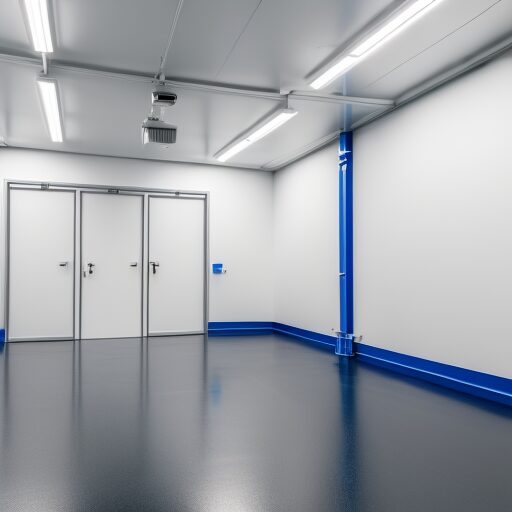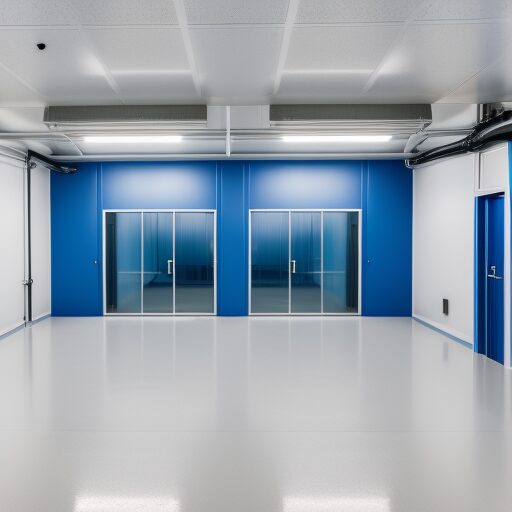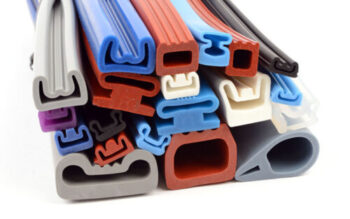Cleanrooms, also known as white rooms, play a critical role in various industrial sectors. In this introduction, we will explore what cleanrooms are and the importance they have in different industrial areas. These highly controlled environments not only contribute to ensuring the quality and safety of products but also play an essential role in protecting the health and well-being of people, as well as preserving the environment. Throughout this analysis, we will discover how these specialized facilities are crucial in the production of medical devices, pharmaceutical research, electronics, the aerospace industry, and many other fields, providing a contaminant-free environment that complies with rigorous standards to meet the needs of each sector.
What are cleanrooms and how do they work
Cleanrooms, also known as white rooms, are highly controlled work environments designed to maintain an extremely low level of airborne particles and contaminants while also regulating factors such as temperature, humidity, and pressure. These facilities are utilized across various industrial and scientific sectors where environmental contamination could have severe consequences. This includes the production of medical devices, pharmaceutical research, electronics, aerospace, semiconductor manufacturing, and nanotechnology, among others.
Cleanrooms serve several essential purposes:
- Contaminant Control: The primary objective of cleanrooms is to provide an environment free of particles and contaminants that could adversely affect the production of sensitive products or critical processes. These particles can include dust, microorganisms, fibers, chemicals, or even particles too small for the human eye to see.
- Quality Assurance: In industries like pharmaceuticals, electronics, and aerospace, product purity and quality are paramount. Cleanrooms ensure that manufactured products meet the strictest standards of quality and safety by minimizing the possibility of contamination.
- Health and Safety Protection: In medical applications, such as medical device manufacturing or drug research, cleanrooms are critical in ensuring patient safety by preventing contamination of medical products.
- Research and Development: Research laboratories rely on cleanrooms to provide a controlled environment for sensitive experiments where even minor impurities could impact results.
- Electronics and Semiconductor Industry: The manufacturing of electronic components and semiconductors requires the elimination of dust and contaminants to ensure the proper functioning of electronic devices.
- Temperature and Humidity Control: In applications that demand precise environmental conditions, such as nanotechnology, cleanrooms allow for the accurate control of temperature and humidity.
Cleanrooms play a pivotal role in maintaining product quality, safety, and research integrity across diverse industries, offering a controlled and contaminant-free environment for critical processes and applications.
In which industries are cleanrooms used
Cleanrooms are predominantly used in a wide variety of sectors where environmental contamination could have negative consequences for product or process quality, safety, and performance. Some of the most common sectors in which cleanrooms are used include:
- Pharmaceutical Industry: Cleanrooms are essential for ensuring the quality and safety of pharmaceutical products and compliance with health regulations.
- Electronics and Semiconductor Technology: The manufacturing of electronic components, integrated circuits, and semiconductors requires cleanroom conditions to prevent particle contamination and ensure device functionality.
- Medical Devices: The production of medical devices, such as implants, diagnostic equipment, and surgical products, takes place in cleanrooms to ensure sterility and quality.
- Aerospace Industry: The manufacturing and assembly of aerospace components and equipment demand cleanroom environments to prevent particles that could affect the safety and performance of aircraft and satellites.
- Scientific Research: Research laboratories in various disciplines, including physics, chemistry, and biology, use cleanrooms for sensitive experiments and analysis.
- Nanotechnology: Nanotechnology requires highly controlled environments for manipulating materials at the nanometer level, where contamination could alter results.
- Food Production: Cleanrooms are necessary in food production, especially for the manufacturing of sensitive products like dairy and beverages, to maintain quality and hygiene.
- Optical Product Manufacturing: The production of lenses, optical devices, and related products requires particle-free environments that can affect optical clarity.
- Automotive Industry: Certain stages of vehicle manufacturing, such as painting and electronic component assembly, take place in cleanrooms to ensure the quality of automobiles.
- Healthcare and Medical Facilities: Cleanrooms are used in hospitals and clinics for surgical areas and isolation rooms to protect patients and medical staff from infections and contaminants.



The importance of a hermetic seal in cleanrooms: the role of inflatable seals
A hermetic seal in cleanrooms is of vital importance due to its fundamental role in controlling contamination. These facilities are designed to maintain an extremely clean environment free of particles, ensuring the quality, safety, and sterility of products and processes in critical sectors such as the pharmaceutical industry, electronics, and medical device manufacturing. An efficient hermetic seal prevents the infiltration of particles, unwanted gases, or microorganisms from the surrounding environment, which is essential for compliance with rigorous regulations and quality standards.
Inflatable seals play a key role in creating this hermetic seal in cleanrooms. These inflatable seals act as flexible and adaptable seals that expand when compressed air is injected into them, conforming to the joining surfaces and preventing the leakage of unwanted particles or contaminants. Their ability to hermetically seal doors, windows, or passages is crucial for maintaining controlled conditions within a cleanroom and preventing the entry of particles while preserving critical environmental conditions. In summary, inflatable seals are essential components in preserving the integrity of cleanrooms and their ability to meet the purity and quality standards required in various industries.

Broad range of profiles and materials: SEP inflatable seals
Inflatable seals from the SEP (Specialized Engineering Products) brand are known for their exceptional quality and versatility. The company offers a wide range of materials and profiles, allowing these inflatable seals to be customized for a variety of applications in critical sectors such as the pharmaceutical, electronics, and aerospace industries. The quality and diversity of options available in SEP’s seal offerings provide businesses with the confidence to rely on reliable and tailored solutions for maintaining the integrity of their processes and products in demanding environments.
BULTZ: Official SEP Distributor
BULTZ is the official distributor of the prestigious SEP brand for the supply of inflatable seals to companies. This partnership ensures that companies have access to high-quality sealing solutions backed by SEP’s reputation, coupled with BULTZ’s technical expertise to meet their specific sealing needs.
CONTACT US
RELATED POSTS

